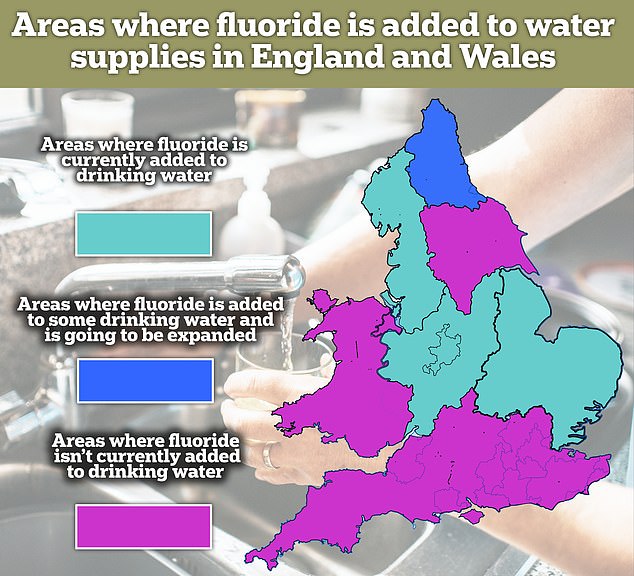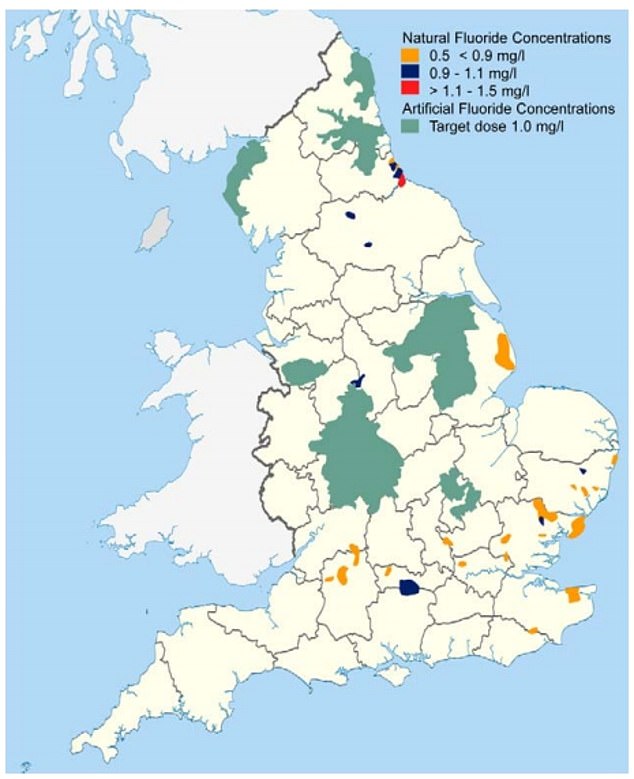A threat to human health: Lawmakers’ verdict on fluoride in water as government plans to put chemicals in UK taps
The British government’s plan to add a chemical to tap water poses an ‘unreasonable risk to human health’, according to a US court ruling.
Earlier this year, ministers announced the imminent launch of a plan to add fluoride to the drinking water supplies of a further 1.6 million Britons in a bid to improve the country’s oral health.
But in the culmination of a seven-year legal battle between environmental health chiefs and water safety activists, a California judge ruled that higher levels of the chemical are “dangerous,” especially to children.
The judge ordered the U.S. Environmental Protection Agency to further regulate fluoride levels in U.S. tap water.
A California judge has ruled that fluoride in tap water must be controlled because of the ‘unreasonable’ risk to children’s health
The court heard “substantial and scientifically credible evidence” about the health harms, including findings suggesting that fluoride exposure can lower children’s IQ.
Judges in the US have set the safe level of fluoride in water at 0.4 mg/l. The British government wants levels to be twice as high.
Although scientists once thought this was a tin foil hat theory, scientists are increasingly warning about the dangers of exposure to high doses of the naturally occurring mineral over the course of a lifetime.
Stephen Peckham, professor of health policy at the University of Kent, said The Telegraph: ‘The ruling is important because it forces the US regulator to take action, and it is quite clear that above a certain level there is an unacceptable risk.
“The judge believes the evidence is overwhelming.
‘Fluoridation has implications for the brain and my personal view is that the weight of evidence is strongly against fluoridation in the community.’

This map shows areas in England and Wales where fluoride is added directly to the drinking water supply. Some areas in Britain have naturally high levels of the mineral in the water and are not shown on this map
Several studies published in recent years have raised concerns about high levels of fluoride and its link to health problems.
Earlier this year, US experts surveyed a group of 230 mother and child pairs and found that those with higher fluoride levels during pregnancy were more likely to have a child with a neurological behavioral problem by the time their child turned three years old.
These problems include symptoms of anxiety and emotional regulation.
Children of women with higher levels of fluoride in their urine were also more likely to experience headaches and stomach pain, the authors noted.
Other studies have linked excessive amounts of the mineral to babies born with Down syndrome, as well as kidney stones and some cancers.

According to the British Fluoridation Society, only 6.1 million Britons – around 10 percent of the population – currently receive water with sufficient fluoride content to benefit oral health. These areas include Hartlepool, Easington, parts of North Hampshire and South Berkshire
However, the NHS and experts such as the government’s chief medical officer, Sir Chris Whitty, say these claims are not supported by evidence.
Professor Whitty has previously described them as ‘exaggerated and unproven’.
Health bosses estimate that adding fluoride to Britain’s water supply could prevent two-thirds of hospital admissions for tooth decay, an issue costing the NHS, and by extension the taxpayer, millions.
About 5.8 million Britons live in areas where fluoride – also added to toothpastes and mouthwashes – is put in tap water, about a tenth of the population.
However, there are government plans to expand this to a further 1.6 million people in the North East.
The figure of 5.8 million does not include areas in Britain where water supplies are naturally high in fluoride; approximately 300,000 people drink supplies naturally fluoridated by rocks in the ground.
Fluoridation is much more common in the US, with about 73 percent of the population adding the mineral to the water supply at a concentration of about 0.7 mg per liter.
